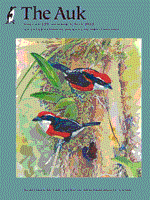Differential reproductive investment between sexes can lead to asymmetric costs of reproduction in birds. Long-lived procellariiform seabirds are single-egg layers with little sexual dimorphism and similar parental investment in incubation and chick rearing. However, sex-specific tasks exist at the beginning of the breeding season, including egg production by females (no courtship feeding by males in this group of species) and nest and mate guarding by males. Costs of reproduction could be evident during critical periods such as the first breeding attempt, because of inexperience in reproductive tasks or a higher proportion of low-quality individuals in young age classes, or both. Little is known about sex-specific costs of reproduction in monomorphic species, in which we expect costs to be similar. We investigated the effects of first reproduction on the subsequent survival of male and female European Storm-Petrels (Hydrobates pelagicus) and found that female survival (0.72; 95% confidence interval [CI]: 0.60–0.82) was lower than that of males (0.85; 95% CI: 0.76–0.89) after first reproduction. However, these differences were not observed in subsequent breeding attempts by experienced females (0.89; 95% CI: 0.86–0.91) and males (0.88; 95% CI: 0.86–0.91), probably because of an experience-related improvement in foraging efficiency, reproductive tasks, or predator avoidance. The effort invested by inexperienced females in the production of a large egg (≤25% of adult body mass) may explain our observed differences in survival.
How to translate text using browser tools
1 July 2012
Is Laying a Large Egg Expensive? Female-Biased Cost of First Reproduction in a Petrel
Ana Sanz-Aguilar,
Eduardo Mínguez,
Daniel Oro
ACCESS THE FULL ARTICLE

The Auk
Vol. 129 • No. 3
July 2012
Vol. 129 • No. 3
July 2012
breeding biology
egg size
European Storm-Petrel
first reproduction
Hydrobates pelagicus
mark—recapture statistics
reproductive effort




